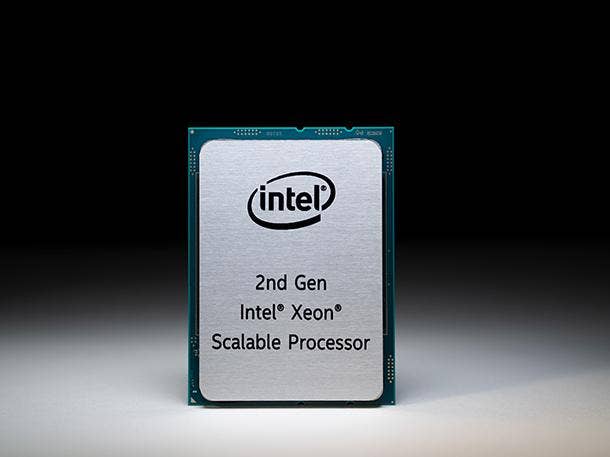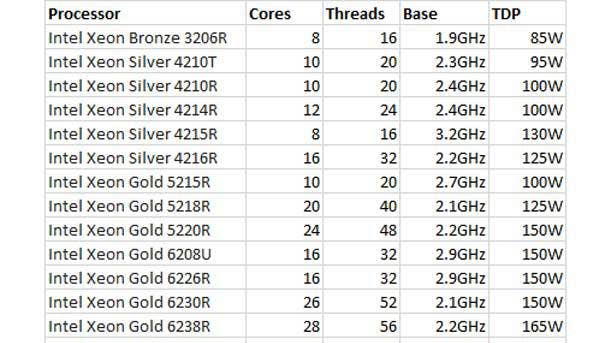Intel Set To Unleash ‘Cascade Lake Refresh’ In AMD EPYC Attack
“AMD is forcing them to compete on core count. It will enable Intel to do a better job of spec matching against AMD's [processors],” one Intel partner said of the chipmaker's upcoming “Cascade Lake Refresh” processors that will be part of the second-generation Xeon Scalable product line.

Intel is set to refresh its second-generation Xeon Scalable server processors in a bid to put pressure on rival AMD’s EPYC multicore processor blitz — a move that could alleviate the ongoing Xeon processor shortage, sources said.
The 18 new processors, which are code - named "Cascade Lake Refresh,” will provide partners with additional cores, higher clock frequencies and higher cache within the mainstream and value portions of the Xeon Scalable lineup, according to three industry sources with knowledge of Intel's plans. The sources asked to not be identified because they were not authorized to speak about the matter.
[Related: Intel Cuts Prices Of 2nd-Gen Xeon Scalable CPUs With High Memory Capacity]
Intel is expected to announce the Cascade Lake Refresh processors on Feb. 23, one source said. Santa Clara, Calif.-based Intel declined to comment.
Cascade Lake Refresh represents Intel’s bid to fight back with higher core counts against the AMD EPYC Rome processors that launched last year, said Marc Fertik, vice president of technology solutions at Ace Computers, an Elk Grove Village, Ill.-based Intel partner.
"AMD is forcing them to compete on core count," he said. "The only way to improve performance without dramatically increasing power consumption is higher core counts. It will enable Intel to do a better job of spec matching against AMD's [processors]."
While sources contacted by CRN could not confirm pricing of the forthcoming Cascade Lake Refresh line, several said they expect pricing to be similar to their corresponding Cascade Lake SKUs, meaning the new processors would help narrow the price-performance gap against AMD. AMD has claimed that the EPYC Rome platform’s performance-per-dollar advantage ranges from 1.8x to 4x Intel’s Cascade Lake lineup.
If the pricing of Cascade Lake Refresh does fall in line with corresponding Cascade Lake SKUs, it would help give Intel an edge in competitive bids against AMD, said Eliot Eshelman, vice president of strategic accounts and high-performance computing initiatives at Microway, a Plymouth, Mass.-based high-performance computing Intel partner.
"This is going to sweeten the deal for Xeon," he said. "It's going to be more cost effective."
An AMD spokesperson declined to comment beyond stating the company's "confidence in its current products and future roadmap," which "continues to see significant interest from customers."
Intel’s new processors could also help improve Xeon supply constraints that have been felt around the channel, sources said, although it's unclear to what extent the launch would resolve the overall product mix issues Intel has reported.
"It might help alleviate some of the supply chain issues, assuming your customer is not impacted with per-core licensing costs," Fertik said.
One of CRN's sources said the Cascade Lake Refresh processors could be one reason why some Intel partners have been experiencing a Cascade Lake shortage since Intel has likely started shifting some production capacity to the new parts. Distributor Fusion Worldwide said as much in a Dec. 12, 2019, note.
“We are hearing that Intel is sharing some capacity to focus on the Cascade Lake Refresh, which could be another driver of the recent shortages on Cascade Lake,” reads the Fusion Worldwide post.

(Data provided by CRN sources)
From 8-Core Xeon Bronze 3206R To 28-Core Xeon Gold 6258R
The new processors, most of which will be denoted with an "R" suffix in the SKU names, have already appeared on some OEM websites, including Dell Technologies, Lenovo, Hewlett Packard Enterprise, Tyan and Penguin Computing. A few SKUs have also appeared in two recent Intel microcode updates.
With 18 processors ranging from eight to 28 cores, Cascade Lake Refresh will be part of Intel's second-generation Xeon Scalable lineup and provide performance improvements over select corresponding SKUs that launched last year, sources said. They are separate from the upcoming Cooper Lake processors that will represent a next-generation Xeon Scalable product line.
Intel plans to target AMD's higher-end EPYC processors with 56-core Cooper Lake CPUs later this year and, sometime after that, Ice Lake CPUs, which will be Intel's first server processors to use the chipmaker's 10-nanometer process technology. AMD EPYC Rome processors scale from eight cores to 64 cores. At the high end, it currently includes 36 cores more than Intel's top Cascade Lake Scalable Performance offering and eight more cores than Intel's Cascade Lake Advanced Performance server offering.
The Cascade Lake Refresh chips will target the mainstream and value ends of the server market, with processors ranging from the Xeon Bronze 3206R, which will have eight cores, a 1.9GHz base frequency, an 11 MB cache and an 85W TDP, to the Xeon Gold 6258R, which will have 28 cores, a 2.7GHz base frequency, a 38.5 MB cache and a 205W TDP, according to information published on OEM sites that was corroborated by CRN's sources.
The other SKUs in the Cascade Lake Refresh lineup include the Xeon Silver 4210R, Xeon Silver 4214R, Xeon Silver 4215R, Xeon Silver 4216R, Xeon Gold 5215R, Xeon Gold 5218R, Xeon Gold 5220R, Xeon Gold 6226R, Xeon Gold 6230R, Xeon Gold 6238R, Xeon Gold 6240R, Xeon Gold 6242R, Xeon Gold 6246R and Xeon Gold 6248R. The lineup will also include the Xeon Silver 4210T, a lower-power model of the Xeon 4210R that runs at 95W, and the one-socket Xeon Gold 6208U.
Like their Cascade Lake predecessors, these processors will support Intel Optane DC persistent memory and include the company's Deep Learning Boost feature, sources said. All of them appear to support Hyper-Threading, according to OEM listings. However, more details about specific features, including turbo frequencies for each processor, could not be discerned or corroborated.
With the exception of the Xeon Bronze 3206R and Xeon Gold 6258R, the Cascade Lake Refresh processors have corresponding SKUs from last year's Cascade Lake launch. Of the processors with corresponding SKUs, at least nine have higher core counts while at least 11 have higher base frequencies. A few of the processors have both, like the Xeon Gold 6238R, which has 28 cores and a 2.2GHz base frequency — an additional six cores and 100MHz over the Xeon Gold 6238.
Higher core counts can be beneficial for workloads like virtualization that are based on "per socket" licensing costs, meaning the more cores packed into a single socket, the better the cost savings. In a comparison provided by AMD last year, the chipmaker showed how its 40 single-socket, 64-core EPYC 7702P processors can run the same number of virtual machines as 80 dual-socket, 16-core Intel Xeon Gold 6242 processors for more than half the cost.
The closest corresponding SKU for the new Xeon Gold 6258R from last year's Cascade Lake lineup would be the Xeon Gold 6254. With its 28 cores, Xeon Gold 6258R would have 10 more cores than the Xeon Gold 6254. Along with the Xeon Gold 6238R, the two processors will have the most cores out of any Xeon Gold processor in Intel's history. Currently, if a customer wanted a second-generation Xeon Scalable processor with 28 cores, they would have to choose a Xeon Platinum 8276 at the minimum.
For the Xeon Bronze 3206R, the closest corresponding SKU from last year's Cascade Lake lineup would be the Xeon Bronze 3204. With eight cores, the Xeon Bronze 3206R has two more cores and an additional 2.75 MB in cache, with no difference in base frequency, over the Xeon Bronze 3204.
The new details have emerged after German news site Tweakers published a leaked server roadmap last year showing that Cascade Lake Refresh is due to launch in the first quarter of 2020.
Dominic Daninger, vice president of engineering at Nor-Tech, a Burnsville, Minn.-based high-performance computing Intel partner, said the increased core counts, frequencies and cache of the Cascade Lake Refresh processors show that Intel is continuing to find ways to refine its 14-nanometer process, which debuted in 2014 with Intel's Broadwell processors.
"I think what you're seeing is their fab process is maturing, so they're probably getting better yields, and that’s what allows them to put out these premium parts," he said.